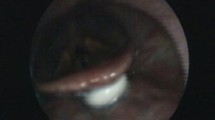Abstract
Background
Gastroesophageal reflux disease (GERD) is a cause of dysphagia. Our aim in this investigation was to evaluate the duration of the oral and pharyngeal transit in patients with GERD, with the hypothesis that these patients may have an alteration of oral–pharyngeal transit.
Method
The swallow of 31 patients with GERD, 27 with erosive esophagitis, 15 with mild dysphagia for solid foods, and 26 controls was evaluated by the videofluoroscopic method. Controls and patients swallowed in duplicate 5 and 10 mL boluses of liquid and paste consistency.
Results
Transit was longer in patients with GERD than controls through the upper esophageal sphincter with 5 mL liquid bolus [controls: 0.39 (0.10) s, GERD: 0.47 (0.21) s, p = 0.01], through the mouth and from mouth to esophagus with 10 mL liquid bolus, and through the pharynx, and upper esophageal sphincter [0.45 (0.11) s, GERD: 0.51 (0.26) s, p = 0.01] with 10 mL paste bolus. In patients with erosive esophagitis and dysphagia, the duration of transit through the upper esophageal sphincter was longer in patients than in controls. Such difference was not seen when the upper esophageal sphincter transit duration of patients with erosive esophagitis without dysphagia was compared with controls. There was no bolus aspiration into the airway in any subject. Pharyngeal residues were seen in the same proportion of patients and controls.
Conclusion
Swallowed bolus flow through the upper esophageal sphincter of patients with GERD is slower than that seen in normal volunteers, mainly in patients with erosive disease associated with dysphagia.


Similar content being viewed by others
References
Yuksel ES, Vaezi MF. Extraesophageal manifestations of gastroesophageal reflux disease: cough, asthma, laryngitis, chest pain. Swiss Med Wkly. 2012;142:w13544.
Richter JE. The many manifestations of gastroesophageal reflux disease: presentation evaluation and treatment. Gastroenterol Clin N Am. 2007;36:577–99.
Eslick GD, Talley NJ. Dysphagia: epidemiology, risk factors and impact on quality o life—a population-based study. Alim Pharmacol Ther. 2008;27:971–9.
Vakil NB, Traxler B, Levine D. Dysphagia in patients with erosive esophagitis: prevalence, severity, and response to proton pump inhibitor treatment. Clin Gastroenterol Hepatol. 2004;2:665–8.
Lazarescu A, Karamanolis G, Aprile R, Oliveira RB, Dantas R, Sifrim D. Perception of dysphagia: lack of correlation with objective measurements of esophageal function. Neurogastroenterol Motil. 2010;22:1292–7.
Lang IM. Brain stem control of the phases of swallowing. Dysphagia. 2009;24:333–48.
Massey BT. Pathological pharyngo-esophageal interactions. Dysphagia. 1995;10:232–4.
Triadafilopoulos G, Hallstone A, Nelson-Abbott H, Bedinger K. Oropharyngeal and esophageal interrelationships in patients with nonobstructive dysphagia. Dig Dis Sci. 1992;37:551–7.
Santos CM, Cassiani RA, Dantas RO. Videofluoroscopic evaluation of swallowing in Chagas’ disease. Dysphagia. 2011;26:361–5.
Jones B, Ravich WJ, Donner MW, Kramer SS, Hendrix TR. Pharyngoesophageal interrelationships: observations and working concepts. Gastrointest Radiol. 1985;10:225–33.
Cherry J, Siegel CI, Margulis SI, Donner MW. Pharyngeal localization of symptoms of gastroesophageal reflux. Ann Otol Rhinol Laryngol. 1970;79:912–4.
Bredenoord AJ, Pandolfino JE, Smout AJPM. Gastro-oesophageal reflux disease. Lancet. 2013;381:1933–42.
Mendell DA, Logemann JA. A retrospective analysis of the pharyngeal swallow in patients with clinical diagnosis of GERD compared with normal controls: a pilot study. Dysphagia. 2002;17:220–6.
White RJ, Morris GP, Paterson WG. Impairment of deglutition reflex by acid-induced esophageal mucosal injury. Dig Dis Sci. 2001;46:802–7.
Lundell LR, Dent J, Bennett JR, Blum AL, Armstrong D, Galmich JP, et al. Endoscopic assessment of oesophagitis: clinical and functional correlates and further validation of Los Angeles classification. Gut. 1999;45:172–80.
Leite LP, Johnston BT, Barrett J, Castell JA, Castell DO. Ineffective esophageal motility (IEM). The primary finding in patients with nonspecific esophageal motility disorder. Dig Dis Sci. 1997;42:1859–65.
Schall R. Estimation in generalized linear models with random effects. Biometrika. 1991;78:719–27.
Littell RC, Milliken GA, Stroup WW, Wolfinger RD. SAS system of non-linear mixed models. Cary: SAS Institute Inc.; 1996.
Kidambi T, Toto E, Ho N, Taft T, Hirano I. Temporal trends in the relative prevalence of dysphagia in reflux esophagitis. World J Gastroenterol. 2012;18:4335–41.
Triadafilopoulos G. Nonobstructive dysphagia in reflux esophagitis. Am J Gastroenterol. 1989;84:614–8.
Buthpitiya AG, Stroud D, Russell COH. Pharyngeal pump and esophageal transit. Dig Dis Sci. 1987;32:1244–8.
Yoshikawa H, Kuruta K, Ueno M, Egawa M, Yoshino A, Kondo S, et al. Oral symptoms including dental erosion in gastroesophageal reflux disease are associated with decreased salivary flow volume and swallowing function. J Gastroenterol. 2012;47:412–20.
Koç H, Vinyard CJ, Essick GK, Foegeding EA. Food oral processing: conversion of food structure to textual perception. Annu Rev Food Sci Technol. 2013;4:237–66.
Dantas RO, Aprile LRO. Esophageal striated muscle contractions in patients with gastroesophageal reflux symptoms. Dig Dis Sci. 2002;47:2586–90.
Szczesniak MM, Fuentealba SE, Cook IJ. Acid sensitization of esophageal mucosa afferents: implication for symptom perception in patients across the gastroesophageal reflux disease spectrum. Clin J Pain. 2013;29:70–7.
Savarino E, Gemignani L, Pohl D, Zentilin P, Dulbecco P, Assandri L, et al. Oesophageal motility and bolus transit abnormalities increase in parallel with severity of gastro-oesophageal relux disease. Alim Pharmacol Ther. 2011;34:476–86.
Alkan T, Demir A, Yigit O, Adatepe T, Kesici B, Kocak I, et al. Cricopharyngeal muscle electromyography findings in patients with gastroesophgaeal reflux disease. Otolaryngol Head Neck Surg. 2012;147:295–301.
Alves LMT, Secaf M, Dantas RO. Oral, pharyngeal, and esophageal transit of an acidic bolus in healthy subjects. Esophagus. 2013;10:217–22.
Shaw SM, Martino R. The normal swallow. Muscular and neurophysiologic control. Otolaryngol Clin N Am. 2013;46:937–56.
Madanick RD. Proton pump inhibitor side effects and drug interations: much ado about nothing? Cleve Clin J Med. 2011;78:39–49.
Ethical Statement
All procedures followed in this investigation were in concordance with the ethical standards of the responsible committee on human experimentation (institutional and national) and with the Helsinki Declaration of 1964 and later versions.
Conflict of interest
There is no conflict of interest for Rachel A Cassiani, Gustavo A Mota, and Roberto O Dantas.
Author information
Authors and Affiliations
Corresponding author
Rights and permissions
About this article
Cite this article
Cassiani, R.A., Mota, G.A. & Dantas, R.O. Oral and pharyngeal bolus transit in gastroesophageal reflux disease. Esophagus 12, 345–351 (2015). https://doi.org/10.1007/s10388-014-0481-1
Received:
Accepted:
Published:
Issue Date:
DOI: https://doi.org/10.1007/s10388-014-0481-1




